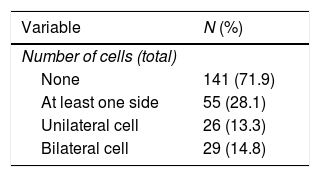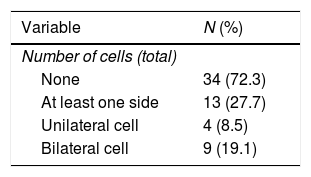A pneumatised middle turbinate is called concha bullosa. It has been classified according to its extension in the coronal plane. We propose the first classification according to the axial extension of pneumatisation of the middle turbinate.
Material and methodsBulbous concha bullosa was classified in six categories according to the degree of pneumatisation of the body of the middle turbinate in the axial plane.
Results196 CT sinonasal scans were included. 28.06% of patients had concha bullosa, unilateral in 13.26% and bilateral in 14.79%. The most common concha bullosa found was type I, followed by type III, II, IV and V. There were no statistically significant differences by side, between the patients with or without chronic rhinosinusitis without polyps.
ConclusionOur results support the hypothesis that concha bullosa is not related to chronic rhinosinusitis. Furthermore, type IV and V cells mean posterior aeration of the middle turbinate. Those variations are rare and posterior, so they can easily pass unnoticed during endoscopic sinus surgery. Our classification is also important as a surgical reference, and it can be easily studied on the preoperative CT scan.
El cornete medio bulloso se define como una neumatización del cornete medio. Ha sido clasificado de acuerdo a la extensión de la neumatización en el plano coronal. En este trabajo proponemos la primera clasificación de acuerdo a la extensión de la neumatización en el plano axial.
Material y métodosLa concha bullosa bulbar se clasificó en 6 variantes de acuerdo al grado de neumatización del cuerpo del cornete medio en el plano axial.
ResultadosSe incluyeron 196 TC nasosinusales. Se encontró una concha bullosa bulbar en el 28,06% de los pacientes, unilateral en el 13,26% y bilateral en el 14,79%. La variante más frecuente fue la tipo i, seguida de las tipo iii, ii, iv y v. No se encontraron diferencias estadísticamente significativas por lado. Tampoco se encontraron diferencias estadísticamente significativas al comparar subgrupos de pacientes con y sin rinosinusitis crónica sin pólipos.
ConclusiónNuestros resultados sustentan la hipótesis de que el cornete medio bulloso no es causa de rinosinusitis crónica. Por otra parte, las celda tipo iv y v implican una neumatización posterior del cornete medio. Estas variantes son raras, y posteriores, de modo que pueden pasar fácilmente desapercibidas durante la cirugía endoscópica. Asimismo, esta clasificación es importante como referencia quirúrgica que puede estudiarse con facilidad en el estudio preoperatorio de la TC nasosinusal.









